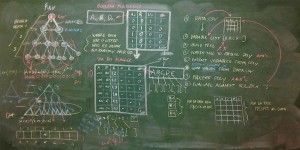GP update 2015 05/26
(email to my fellow researchers)
A week has come and gone. And with it, some 60 hours coding, if not more. I have accomplished a great deal, further fine-tuning the code, building tool-sets, and building a stronger method-based platform for GP. I can now build a Tree from the command line in 5 lines of code, evaluate for fitness, mutate, and save with a few more.
While I witnessed my GP converge on a solution a few nights ago for the first time, using only reproduction (copy) and simple point mutation, I have not yet completed crossover nor the grow method for branch mutation.
These have proved to be incredibly, mentally challenging. I have never struggled with something at this level (I want to say “in my life,” but I may not be thinking clearly :)
I freely admit the issue is not one of Python, but an incredibly complex array book keeping effort that borders on my having to create my own pointer system.
I spent 3 days exploring work-arounds, tricks, and short-cuts, but in the end, am back to the realisation there is just one way–the hard way.
The good news is that I have slowly eroded the challenge by building a suite of tools, each of which performs a single task. Cool.
I will get there, one step at a time.
Today was lost to the realisation (and subsequent rewrite) that my core Tournament code was (inadvertently) taking advantage of Python’s ability to perform basic comparisons (>, <, =) on strings which contains numbers, as compared to converting those to integers first. It works, but the results are not consistent. Fixed! I am far more confident, even though another day behind my slated sched.
What’s more, Python’s numpy random generator is clearly NOT random by any stretch of the imagination. 100 Trees evolved over 10 generations in non-interactive mode generates far, far more positive results than when I enter interactive mode (code pauses / continues with RETURN). This causes me to believe the random generator is using keyboard input as a random seed, which drastically (and negatively) affects the results.
I will, at another time, replace Numpy with a call to a proper, external random number generator. I see this current effort as computer science more than applied mathematics. However, what I am learning about the underlying structure of code is likely quite valuable.
Been coding till 2 or 3 am every night, photographing when the sky is clear ’till 5 or 6 am. Sleep till 10:30, go for a run, and back to the grind :)
kai




